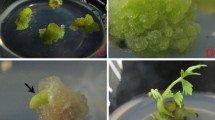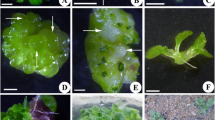Abstract
Curcuma attenuata is a highly valued ornamental. This study provides the first report on C. attenuata shoot organogenesis and plant regeneration. Immature anthers derived from 5 to 7 cm long inflorescences were isolated and cultured on different variations of Murashige and Skoog (MS) media to induce callus and then shoot organogenesis. When the 2-mm long anthers in which microspores were at the uninucleate developmental stage were cultured in the dark on MS medium containing 13.6 μM 2,4-dichlorophenoxyacetic acid (2,4-D) and 2.3 μM kinetin (KT) for 15 days and then transferred to 40 μmol m−2 s−1 fluorescent light for 30 days, the percentage callus induction reached 33.3 %. After callus was transferred to various differentiation media and cultured in the light, 33.1 % of all callus cultures could differentiate into adventitious shoots on MS medium supplemented with 22.0 μM 6-benzyladenine (BA), 0.53 μM α-naphthaleneacetic acid (NAA) and 1.4 μM thidiazuron (TDZ) after culturing for 60 days. Over 95 % of plantlets survived after transplanting plantlets into trays with a mixture of sand and perlite (2: 1) for 20 days. Chromosome number, determined from the root tips of young plantlets, indicated that all plantlets were diploid (2n = 84).


Similar content being viewed by others
Abbreviations
- BA:
-
6-Benzyladenine
- 2,4-D:
-
2,4-Dichlorophenoxyacetic acid
- NAA:
-
α-Naphthaleneacetic acid
- TDZ:
-
Thidiazuron
- KT:
-
Kinetin
- PGR:
-
Plant growth regulator
- MS:
-
Murashige and Skoog
References
Apavatjrut P, Sirisawad T, Sirirugsa P, Voraurai P, Suwanthada C (1996) Studies on chromosome number of seventeen Thai Curcuma species. In: Proceedings of 2nd national conference on flower and ornamental plant, vol 2, pp 86–99
Balachandran SM, Bhat SR, Chandel KPS (1990) In vitro clonal multiplication of turmeric (Curcuma spp.) and ginger (Zingiber officinale Rosc.). Plant Cell Rep 8:521–552
Jana LS, Otakar S, Vlasta J, Mamyil S, Tomáš F, Pavel T, Suda J (2007) Chromosome numbers and genome size variation in Indian species of Curcuma (Zingiberaceae). Ann Bot 100:505–526
Mohanty S, Panda MK, Subudhi E, Nayak S (2008) Plant regeneration from callus culture of Curcuma aromatica and in vitro detection of somaclonal variation through cytophotometric analysis. Biol Plant 52:783–786
Murashige T, Skoog F (1962) A revised medium for rapid growth and bio assays with tobacco tissue cultures. Physiol Plant 15:473–497
Nayak S (2000) In vitro multiplication and microrhizome induction in Curcuma aromatica Salisb. Plant Growth Regul 32:41–47
Prakash S, Elangomathavan RE, Seshadri S, Kathiravan K, Ignacimuthu S (2004) Efficient regeneration of Curcuma amada Roxb. plantlets from rhizome and leaf sheath explants. Plant Cell Tissue Org Cult 78:159–165
Prathanturarug S, Soonthornchareonnon N, Chuakul W, Phaidee Y, Saralamp P (2003a) High-frequency shoot multiplication in Curcuma longa L. using thidiazuron. Plant Cell Rep 21:1054–1059
Prathanturarug S, Soonthornchareonnon N, Chuakul W, Phaidee Y, Saralamp P (2003b) High-frequency shoot multiplication in Curcuma longa L. using thidiazuron. Plant Cell Rep 21:1054–1059
Prathanturarug S, Soonthornchareonnon N, Chuakul W, Phaidee Y, Saralamp P (2005) Rapid micropropagation of Curcuma longa using bud explants pre-cultured in thidiazuron supplemented liquid medium. Plant Cell Tissue Org Cult 80:347–351
Purseglove JW, Brown EG, Green CL, Robbins SR (1981) Spices. Longman, London, New York
Salvi ND, Geoge L, Eapen S (2000) Direct regeneration of shoots from immature inflorescence cultures of turmeric. Plant Cell Tissue Org Cult 62:235–238
Salvi ND, George L, Eapen S (2001) Plant regeneration from leaf base callus of turmeric and random amplified polymorphic DNA analysis of regenerated plants. Plant Cell Tissue Org Cult 66:113–119
Samsudeen K, Babu KN, Divakaran M, Ravindran PN (2000) Plant regeneration from anther derived callus cultures of ginger (Zingiber officinale Rosc.). J Hortic Sci Biotech 75:447–450
Schaffer M, Schaffer PM, Zidan J, Sela GB (2011) Curcuma as a functional food in the control of cancer and inflammation. Curr Opin Clinical Nutrition Metabolic Care 4:588–597
Sit AK, Tiwari RS (1997) Micropropagation of turmeric (Curcuma longa L.). Rec Hortic 4:145–148
Sunitibala H, Damayanti M, Sharma GJ (2001) In vitro propagation and rhizome formation in Curcuma longa Linn. Cytobios 105:71–82
Toppoonyanont N, Chongsang S, Chujan S, Somsueb S, Nuamjaroen P (2005) Micropropagation scheme of Curcuma alismatifolia Gagnep. Acta Hort (ISHS) 673:705–712
Tyagi RK, Yusuf A, Dua P, Agrawal A (2004) In vitro plant regeneration and genotype conservation of eight wild species of Curcuma. Biol Plant 48:129–132
Udomdee W, Fukai S, Petpradap L, Teixeira da Silva JA (2003) Curcuma: studies on tissue culture, pollen germination and viability, histology and flow cytometry. Prop Ornamental Plants 3:34–41
Viu AFM, Viu MAO, Tavares AR, Vianello F, Lima GPP (2009) Endogenous and exogenous polyamines in the organogenesis in Curcuma longa L. Sci Hortic 121:501–504
Wallich N (1828) A numerical list of dried specimens of plants in the East India company’s Museum: collected under the superintendence of Dr. Wallich of the company’s botanic garden at Calcutta. Treuttel and Wurtz, London, pp 6225–7683
Wannakrairoj S (1997) Clonal micropropagation of patumma (Curcuma alismatifolia gagnep). Witthayasan Kasetsart 31:353–356
Xu Q, Teixeira da Silva JA, Kong L (2006) Advanced biotechnology used in Curcuma plant research. In: Teixeira da Silva JA (ed) Floriculture, ornamental and plant biotechnology: advances and topical issues, 1st edn, vol IV. Global Science Books, Ltd., Isleworth, UK, pp 517–528
Zhang XH, Teixeira da Silva JA, Ma GH (2010) Karyotype analysis of Santalum album L. Caryologia 63:142–148
Zhang SJ, Liu N, Sheng AW, Ma GH, Wu GJ (2011) In vitro plant regeneration from organogenic callus of Curcuma kwangsiensis Lindl. (Zingiberaceae). Plant Growth Regul 64:141–145
Acknowledgments
This work was financially supported by the Science and Technology Planning Project of Guangdong Province (2010B020305013), which is gratefully acknowledged.
Author information
Authors and Affiliations
Corresponding authors
Rights and permissions
About this article
Cite this article
Kou, Y., Ma, G., Teixeira da Silva, J.A. et al. Callus induction and shoot organogenesis from anther cultures of Curcuma attenuata Wall. Plant Cell Tiss Organ Cult 112, 1–7 (2013). https://doi.org/10.1007/s11240-012-0205-y
Received:
Accepted:
Published:
Issue Date:
DOI: https://doi.org/10.1007/s11240-012-0205-y




